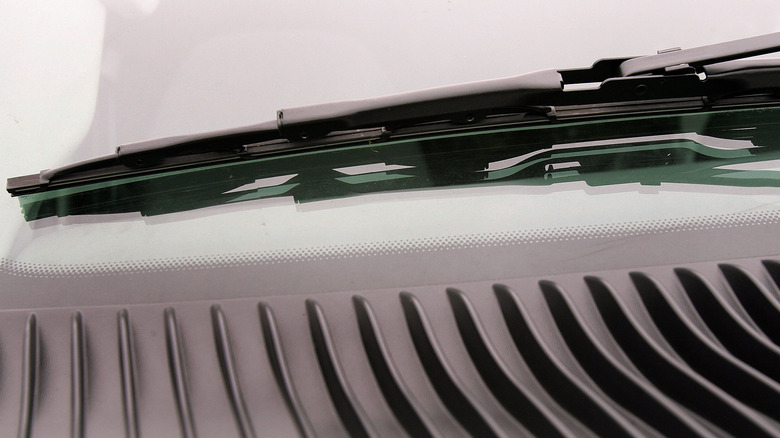Who Invented Windshield Wipers?
You probably don't think too much about your windshield wipers. They come standard on every car, but they aren't usually that flashy — they repeat the same motion over and over so that you can see clearly. The only reason to pay any attention to them at all is if they stop working or need to be replaced, something experts say you should be doing about every six months.
But the windshield wiper wasn't always around. In the first vehicles ever made, nothing prevented the rain and snow from collecting on the glass windows. It took a lot of time and development to get from those early, wiper-free models to the sleek and silent windshield wipers that we know and rely on today. For the inventors behind the essential pieces, it took a lot of effort to get their designs onto vehicles — and even more effort to be recognized for the work that went into creating them.
A snowy day in New York
The earliest version of windshield wipers was a lot different from what we know now. Before sophisticated electronic methods, drivers were expected to operate blades that were a combination of wood and rubber by hand from inside the car, according to The News Wheel. It was better than the alternative, though, which required drivers to lower the windshield and face the weather head-on or else leave their cars repeatedly during bad weather and wipe off the glass by hand.
The idea came from Mary Anderson, a Georgia native who took a winter visit to New York in 1902 (via NPR). Anderson rode on a streetcar during a snowstorm while she was in town. After watching the driver struggle, she developed an idea (per the U.S. Patent Office) for the "window cleaning device for electric cars and other vehicles to remove snow, ice or sleet from the window." The idea didn't exactly catch on — in fact, car companies largely dismissed Anderson and wouldn't incorporate her design into their vehicles. But Anderson's patent is the first evidence of a design for a windshield wiper.
The advent of automation
If you've driven a car in the past 100 years, you probably know that windshield wipers aren't operated by hand anymore. Mary Anderson's original design brought to light the need for wiper technology, and within a few years, hand-operated wipers were available on most vehicles (via The News Wheel). But by 1919, a new change was on the way: wipers that could move by themselves.
Inventor William M. Folberth was the first to create a functional, successful motorized windshield wiper. With his design, drivers could once again have both hands back for driving and other necessary operations. The design was popular and ended up becoming the most prominent version of windshield wipers for the next 30 or so years. According to Back Then History, the primary issue with Folberth's design was the settings. The wipers could be on at full speed, or they could be completely off. So, despite the improvements already made to the invention, there was still room to grow.
An eye for improvement
The next person to try and perfect the windshield wiper took inspiration from a pretty familiar place for most of us. Robert Kearns, a professor at Wayne State University in Detroit, struggled with his vision after an accident at his wedding (via Back Then History). Because of those vision problems, he had a hard time driving in the rain, even with his windshield wipers going.
But Kearns found the solution by looking at how the human eye itself works — particularly the eyelid. According to Back Then History, Kearns examined the eyelid and determined it worked by blinking once every few seconds. That, rather than the on or off settings offered by current windshield wipers, could be the solution that would help drivers stay safe in any number of weather conditions. Kearns developed the idea of intermittent windshield wipers and applied for a patent. Within a few years, the design was in production on Ford vehicles.
Fighting for recognition
Despite their efforts to improve safety and technology for everyone, multiple inventors who worked on the windshield wiper as we know it today didn't get much credit in their lifetimes. Mary Anderson's initial design and patent for a window cleaning device never earned her any money, and manufacturers largely rejected it. "We regret to state we do not consider it to be of such commercial value as would warrant our undertaking its sale," one company wrote Anderson in a letter (via NPR).
After Anderson's patent had expired, the design was added to cars on a broader scale (via A Mighty Girl). And, much like Anderson, Robert Kearns also struggled to make money or gain recognition for his intermittent wipers. According to Edgar Snyder & Associates, Ford Motor Company began producing the wipers on their cars without his help or without purchasing his patent. Kearns received millions of dollars from Ford as a result of a lawsuit, but he later lost the rights to his patents.
Making the world safer
Windshield wipers are an incredible piece of technology, even if we don't think about them much. Without the rubber blades to clear away snow and rain on the road, drivers wouldn't be able to see — or they would have to stop periodically and clear away the precipitation by hand, as Mary Anderson saw on her trip. Despite the struggles inventors faced in receiving recognition during their lifetimes, their names have been preserved in the modern-day.
Anderson was inducted into the Inventors Hall of Fame in 2011 for her hand-operated blade, according to NPR. And the story of Robert Kearns' efforts to claim credit for his intermittent wipers was immortalized in the 2008 movie "Flash of Genius." Windshield wipers are often cited as one of the most important safety features a vehicle has, so the inventors behind them deserve all the credit they can possibly get.





